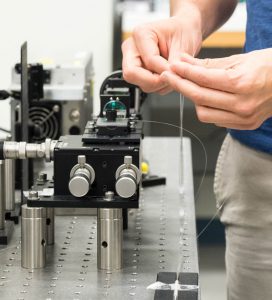Optical Fibers: Light Guiding on a String of Glass
March 2, 2017

New Coherent, Spatial Mode Multiplexing Apparatus Significantly Enhances Fiber Laser Output
About 176 years ago in Geneva, Swiss physicist Jean-Daniel Colladon inadvertently demonstrated one of the core principles of fiber optics: total internal reflection (TIR). TIR is a phenomenon that helps us to purposely move and manipulate light, so that we can use its energy in lighting, remote sensing, communications, and laser technology.
Colladon intended only to help his audience see his experiment on fluid flow through various holes and the breaking up of water jets. He used a tank of water with a small hole that allowed a jet to stream out the side. His audience, however, could not see the results, so he piped sunlight into the tank and used a lens to focus the light on the hole. The setup not only lit up the experiment, but it also caused the light rays in the water to strike the edge of the jet at a glancing angle, allowing TIR to trap the rays in the liquid. Thus, instead of traveling in a straight line, the light rays bounced along the curve of the water jet as it poured out the side of the tank, forming what Colladon called a “light pipe.”
He later wrote: “I managed to illuminate the interior of a stream in a dark space. I have discovered that this strange arrangement offers in results one of the most beautiful, and most curious experiments that one can perform in a course on optics.”
Since Colladon’s time, a host of other scientists and researchers have contributed to the discovery and science of guiding light through fiber optics, revolutionizing the way we view and use light. Optical fibers are hair-thin filaments, typically drawn or extruded from clear, ultra-pure glass, polymers, or a combination of the two. Each fiber consists of a central transparent core through which light travels. The core is surrounded by cladding, which may be the same or other material, but has a lower refractive index to promote TIR and prevent energy loss. A buffer layer protects the fiber from moisture and damage.
There are different fibers for different applications. Single-mode fibers, which are about 8-10 microns in diameter, carry only one mode (ray) of light directly down the fiber—the transverse mode. The multi-mode optical fiber has a much larger core (usually 62.5 microns or larger) and can handle multiple modes. The design and the wavelength of the light propagating in a fiber specify whether the fiber will be multi-mode or single-mode. Yet all optical fibers still do the same thing: guide light.
Remarkably, this fine flexible “string” is so versatile that it lets us use the power of light in so many different ways. Fiber optics technology enables surgeons to detect and destroy cancerous tumors, astronomers to determine the elements of distant stars, engineers to identify structural weaknesses, and soldiers to communicate securely in hostile environments. With fiber optics, lasers can bore through rock and steel or precision cut gemstones and ceramics. Moreover, thanks to fiber optics, anyone with a phone or computer can connect with others around the world, anytime, anywhere.
Even after decades of using fiber optics, there is still a lot to discover. Today, UCF has teams of scientists dedicated to advancing the science of fiber optics. The Center for Research and Education in Optics and Lasers (CREOL) supports research in fiber fabrication, multimaterial fibers, nano-structured fibers, mid-infrared fibers and fiber lasers.
One of those research teams is finding novel methods of fabricating and using fiber optic materials and devices. The Microstructured Fibers and Devices research group, led by Rodrigo Amezcua Correa, Ph.D., is developing both new materials and new structures for fibers. Two areas that the team is working on are the development of new fibers for high-power lasers and for new light sources. The team is also working on increasing the capacity of optical communications. To learn more about Amezcua’s team and their accomplishments, see this month’s faculty feature.
Amezcua’s expertise in fiber optic fabrication has also led to a new invention that can operate in harsh environments. Together with Axel Schülzgen, Ph.D., head of the Fiber Optics research group, and scientist Jose Enrique Antonio-Lopez, Amezcua developed a new class of fiber optic sensors that are ideal for use in harsh environments. The technology, which has been licensed for commercialization by Multicore Photonics, can be used to sense temperature, pressure, strain, acoustic vibration, mechanical vibration or a combination of sensing applications.
UCF has several other fiber optic technologies available for licensing. For more information, contact John Miner.
By: Kathleen Snoeblen